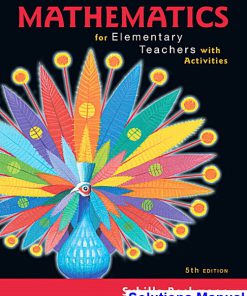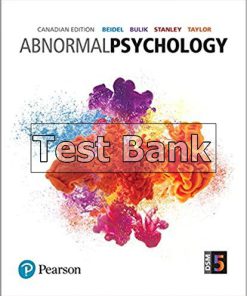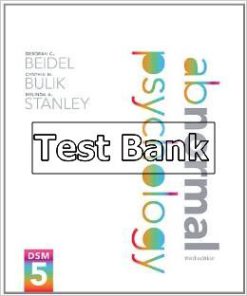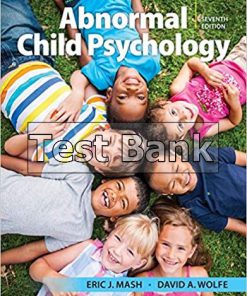Reconceptualizing Mathematics for Elementary School Teachers 3rd Edition Sowder Test Bank
$26.50$50.00 (-47%)
Reconceptualizing Mathematics for Elementary School Teachers 3rd Edition Sowder Test Bank.
You may also like
Reconceptualizing Mathematics for Elementary School Teachers 3rd Edition Sowder Test Bank
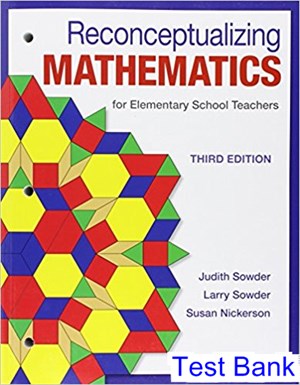
Product details:
- ISBN-10 : 1464193339
- ISBN-13 : 978-1464193330
- Authors: Judith Sowder, Larry Sowder, Larry Nickerson, Susan Nickerson
Table contents:
PART I: REASONING ABOUT NUMBERS AND QUANTITIES
Chapter 1: Reasoning About Quantities
1.1 Ways of Thinking About Solving Story Problems
1.2 Quantitative Analysis
1.3 Problem Solving
1.4 Issues for Learning: Ways of Illustrating Story Problems
1.5 Check Yourself
Chapter 2: Numeration Systems
2.1 Ways of Expressing Values of Quantities
2.2 Place Value
2.3 Bases Other Than Ten
2.4 Operations in Different Bases
2.5 Issues for Learning: Understanding Place Value
2.6 Check Yourself
Chapter 3: Understanding Whole Number Operations
3.1 Ways of Thinking About Addition and Subtraction
3.2 Children’s Ways of Adding and Subtracting
3.3 Ways of Thinking About Multiplication
3.4 Ways of Thinking About Division
3.5 Children Find Products and Quotients
3.6 Issues for Learning: Developing Number Sense
3.7 Check Yourself
Chapter 4: Some Conventional Ways of Computing
4.1 Operating on Whole Numbers and Decimal Numbers
4.2 Issues for Learning: The Role of Algorithms
4.3 Check Yourself
Chapter 5: Using Numbers in Sensible Ways
5.1 Mental Computation
5.2 Computational Estimation
5.3 Estimating Values of Quantities
5.4 Using Scientific Notation for Estimating Values of Very Large and Very Small Quantities
5.5 Issues for Learning: Mental Computation
5.6 Check Yourself
Chapter 6: Meanings for Fractions
6.1 Understanding the Meanings of a/b
6.2 Comparing Fractions
6.3 Equivalent (Equal) Fractions
6.4 Relating Fractions, Decimals, and Percents
6.5 Issues for Learning: Understanding Fractions and Decimals
6.6 Check Yourself
Chapter 7: Computing with Fractions
7.1 Adding and Subtracting Fractions
7.2 Multiplying by a Fraction
7.3 Dividing by a Fraction
7.4 Issues for Learning: Teaching Calculation with Fractions
7.5 Check Yourself
Chapter 8: Multiplicative Comparisons and Multiplicative Reasoning
8.1 Quantitative Analysis of Multiplicative Situations
8.2 Fractions in Multiplicative Comparisons
8.3 Issues for Learning: Standards for Learning
8.4 Check Yourself
Chapter 9: Ratios, Rates, Proportions, and Percents
9.1 Ratio as a Measure
9.2 Comparing Ratios
9.3 Percents in Comparisons and Changes
9.4 Issues for Learning: Developing Proportional Reasoning
9.5 Check Yourself
Chapter 10: Integers and Other Number Systems
10.1 Big Ideas About Signed Numbers
10.2 Children’s Ways of Reasoning About Signed Numbers
10.3 Other Models for Signed Numbers
10.4 Operations with Signed Numbers
10.5 Multiplying and Dividing Signed Numbers
10.6 Number Systems
10.7 Issues for Learning: Open Number Sentences
10.8 Check Yourself
Chapter 11: Number Theory
11.1 Factors and Multiples, Primes and Composites
11.2 Prime Factorization
11.3 Divisibility Tests to Determine Whether a Number is Prime
11.4 Greatest Common Factor, Least Common Multiple
11.5 Issues for Learning: Understanding the Unique Factorization Theorem
11.6 Check Yourself
PART II: REASONING ABOUT ALGEBRA AND CHANGE
Chapter 12: What is Algebra?
12.1 Algebraic Reasoning in Elementary School
12.2 Numerical Patterns and Algebra
12.3 Functions and Algebra
12.4 Algebra as Generalized Arithmetic
12.5 Algebraic Reasoning About Quantities
12.6 Issues for Learning: The National Assessment of Educational Progress and Achievement in Algebra
12.7 Check Yourself
Chapter 13: A Quantitative Approach to Algebra and Graphing
13.1 Using Graphs and Algebra to Show Quantitative Relationships
13.2 Understanding Slope: Making Connections Across Quantitative Situations, Graphs, and Algebraic Equations
13.3 Linear Functions and Proportional Relationships
13.4 Nonlinear Functions
13.5 Issues for Learning: Algebra in the Elementary Grades
13.6 Check Yourself
Chapter 14: Understanding Change: Relationships Among Time, Distance, and Rate
14.1 Distance-Time and Position-Time Graphs
14.2 Using Motion Detectors
14.3 Graphs of Speed Against Time
14.4 Interpreting Graphs
14.5 Issues for Learning: Common Graphing Errors
14.6 Check Yourself
Chapter 15: Further Topics in Algebra and Change
15.1 Finding Linear Equations
15.2 Solving Two Linear Equations in Two Variables
15.3 Different Approaches to Problems
15.4 Average Speed and Weighted Averages
15.5 More About Functions
15.6 Issues for Learning: Topics in Algebra
15.7 Check Yourself
PART III: REASONING ABOUT SHAPES AND MEASUREMENT
Chapter 16: Polygons
16.1 Review of Polygon Vocabulary
16.2 Organizing Shapes
16.3 Triangles and Quadrilaterals
16.4 A Focus on Problem-Solving Strategies
16.5 Issues for Learning: Some Research on Two-Dimensional Shapes
16.6 Check Yourself
Chapter 17: Polyhedra
17.1 Shoeboxes Have Faces and Nets!
17.2 Introduction to Polyhedra
17.3 Representing and Visualizing Polyhedra
17.4 Congruent Polyhedra
17.5 Some Special Polyhedra
17.6 Issues for Learning: Dealing with 3D Shapes
17.7 Check Yourself
Chapter 18: Symmetry
18.1 Symmetry of Shapes in a Plane
18.2 Symmetry of Polyhedra
18.3 Issues for Learning: What Geometry Is in the Pre-K-8 Curriculum?
18.4 Check Yourself
Chapter 19: Tessellations
19.1 Tessellating the Plane
19.2 Tessellating Space
19.3 Check Yourself
Chapter 20: Similarity
20.1 Similarity and Dilations in Planar Figures
20.2 More About Similar Figures
20.3 Similarity in Space Figures
20.4 Issues for Learning: Similarity and Proportional Reasoning
20.5 Check Yourself
Chapter 21: Curves, Constructions, and Curved Surfaces
21.1 Planar Curves and Constructions
21.2 Curved Surfaces
21.3 Issues for Learning: Standards for Mathematical Practice
21.4 Check Yourself
Chapter 22: Transformation Geometry
22.1 Some Types of Rigid Motions
22.2 Finding Images for Rigid Motions
22.3 A Closer Look at Some Rigid Motions
22.4 Composition of Rigid Motions
22.5 Transformations and Earlier Topics
22.6 Issues for Learning: Promoting Visualization in the Curriculum
22.7 Check Yourself
Chapter 23: Measurement Basics
23.1 Key Ideas of Measurement
23.2 Length and Angle Size
23.3 Issues for Learning: Measurement of Length and Angle Size
23.4 Check Yourself
Chapter 24: Area, Surface Area, and Volume
24.1 Area and Surface Area
24.2 Volume
24.3 Issues for Learning: Measurement of Area and Volume
24.4 Check Yourself
Chapter 25: Counting Units Fast: Measurement Formulas
25.1 Circumference, Area, and Surface Area Formulas
25.2 Volume Formulas
25.3 Issues for Learning: What Measurement is in the Curriculum?
25.4 Check Yourself
Chapter 26: Special Topics in Measurement
26.1 The Pythagorean Theorem
26.2 Some Other Kinds of Measurements
26.3 Check Yourself
PART IV: REASONING ABOUT CHANCE AND DATA
Chapter 27: Quantifying Uncertainty
27.1 Understanding Chance Events
27.2 Methods of Assigning Probabilities
27.3 Simulating Probabilistic Situations
27.4 Issues for Learning: Research on the Learning of Probability
27.5 Check Yourself
Chapter 28: Determining More Complicated Probabilities
28.1 Tree Diagrams and Lists for Multistep Experiments
28.2 Probability of One Event or Another Event
28.3 Probability of One Event and Another Event
28.4 Conditional Probability
28.5 Probability and Problem Solving
28.6 Check Yourself
Chapter 29: Introduction to Statistics and Sampling
29.1 What Are Statistics?
29.2 Sampling: The Why and the How
29.3 Simulating Random Sampling
29.4 Types of Data
29.5 Conducting a Survey
29.6 Issues for Learning: Sampling
29.7 Check Yourself
Chapter 30: Representing and Interpreting Data with One Variable
30.1 Representing Categorical Data
30.2 Representing and Interpreting Measurement Data
30.3 Examining the Spread of Data
30.4 Measures of Center
30.5 Deviations from the Mean as Measures of Spread
30.6 Examining Distributions
30.7 Issues for Learning: Understanding the Mean
30.8 Check Yourself
Chapter 31: Dealing with Multiple Data Sets or with Multiple Variables
31.1 Comparing Data Sets
31.2 Lines of Best Fit and Correlation
31.3 Issues for Learning: More Than One Variable
31.4 Check Yourself
Chapter 32: Variability in Samples
32.1 Having Confidence in a Sample Statistic
32.2 Confidence Intervals
32.3 Issues for Learning: What Probability and Statistics Should Be in the Curriculum?
32.4 Check Yourself
Chapter 33: Special Topics in Probability
33.1 Expected Value
33.2 Permutations and Combinations
33.3 Issues for Learning: Children Finding Permutations
33.4 Check Yourself
People also search:
Reconceptualizing Mathematics for Elementary School Teachers 3rd Edition
microeconomics concepts
reconceptualizing mathematics pdf
what is e mathematics
reconceptualizing mathematics for elementary school teachers textbook

